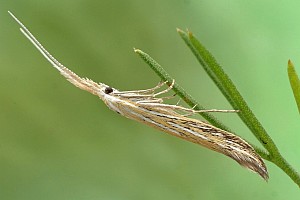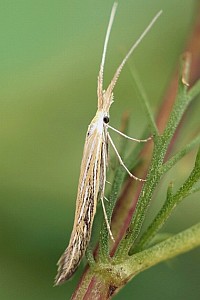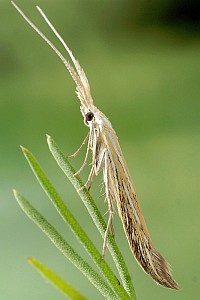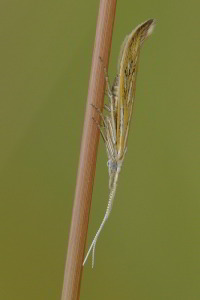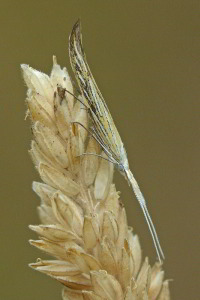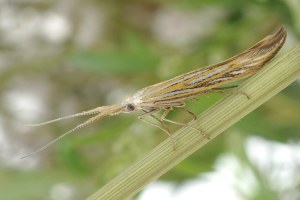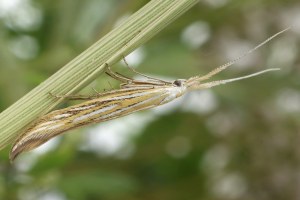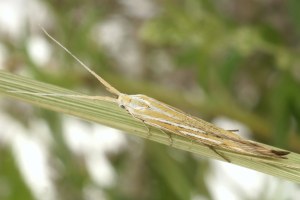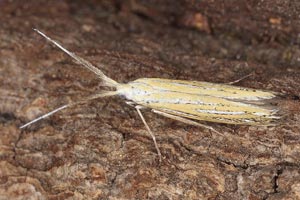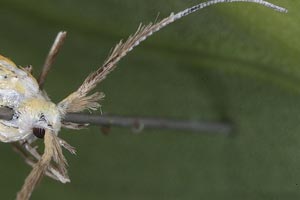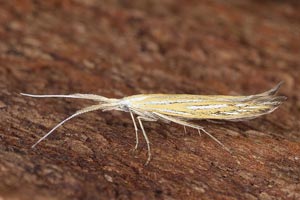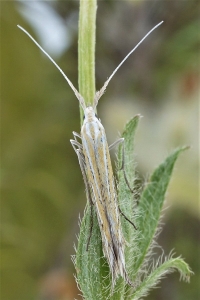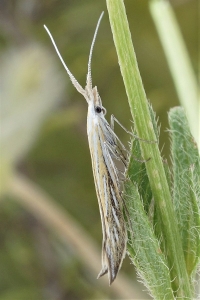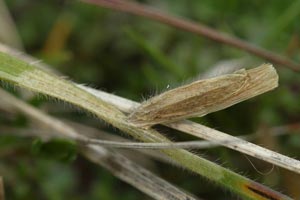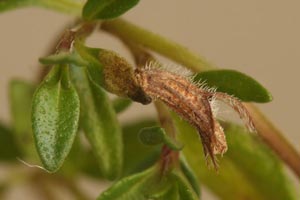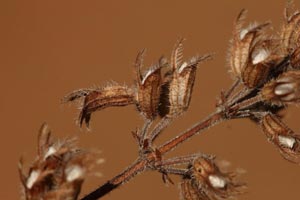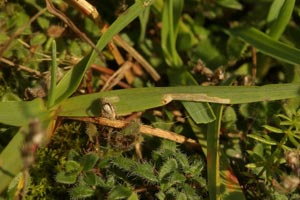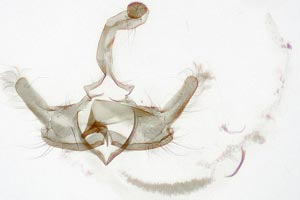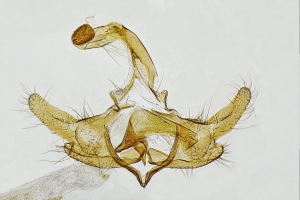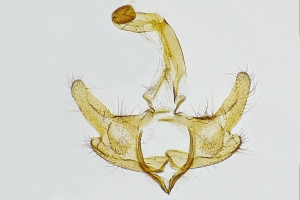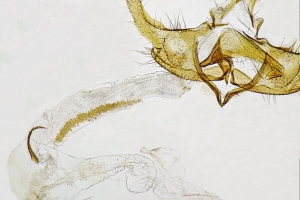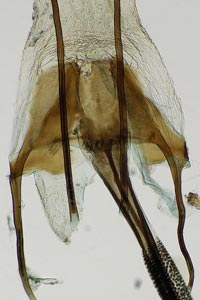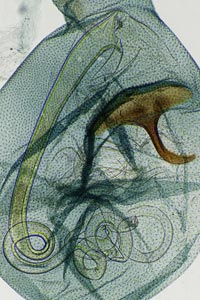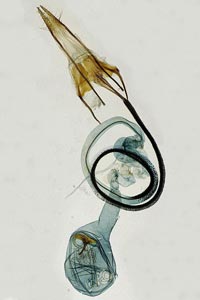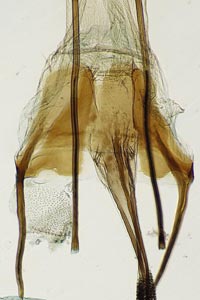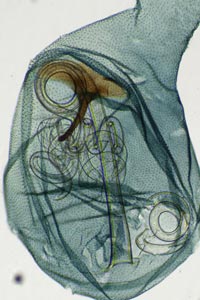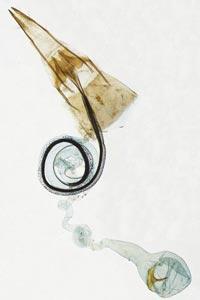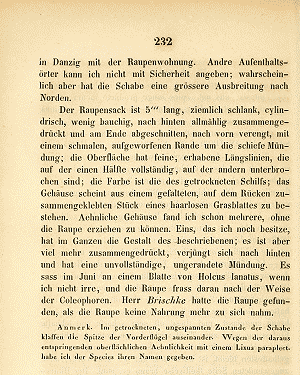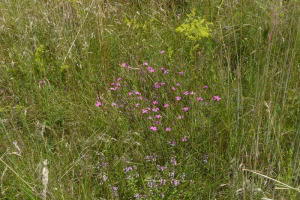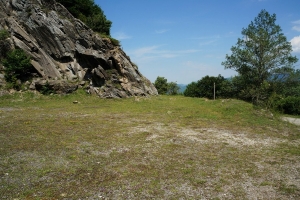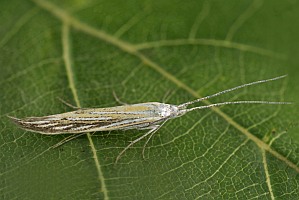
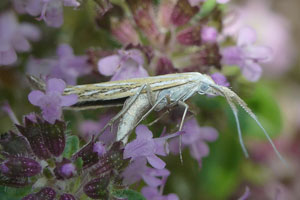


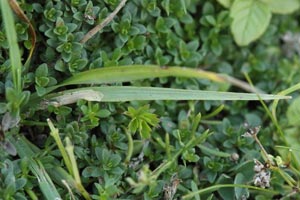
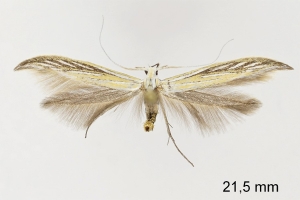

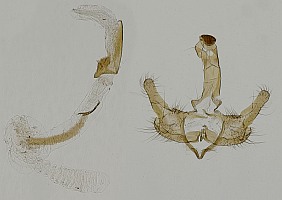
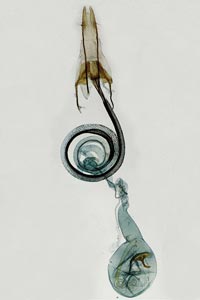
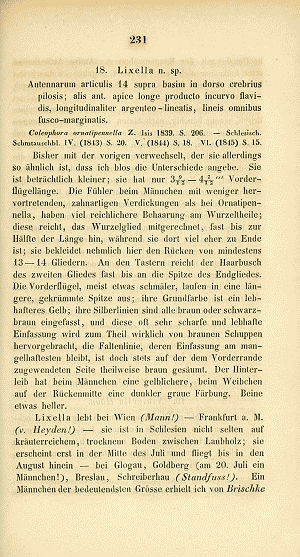
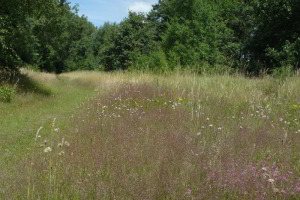
1. Lebendfotos
1.1. Falter
1.2. Eiablage
1.3. Ausgewachsene Raupe, Raupensack
1.4. jüngere Raupen, Raupensack
1.5. Fraßspuren und Befallsbild
2. Diagnose
2.1. Männchen
2.2. Geschlecht nicht bestimmt
2.3. Ähnliche Arten
- Coleophora ornatipennella
- Coleophora lixella
Coleophora ornatipennella und Coleophora lixella weisen eine "gesichelte" Flügelspitze auf.
Coleophora lixella ist etwa ein Drittel kleiner als Coleophora ornatipennella, welche auch für eine Coleophoridae ziemlich groß wirkt.
Coleophora ornatipennella fliegt im Durchschnitt früher im Jahr als Coleophora lixella.
Zum Teil nach einem [Beitrag von Andreas Kopp].
2.4. Genitalien
2.4.1. Männchen
Genitalabbildungen z.B.: Razowski, J.: Motyle (Lepidoptera) Polski 16 - Coleophoridae, p. 195 (♂), p.234 (♀)
2.4.2. Weibchen
2.5. Erstbeschreibung
3. Biologie
Diese Coleophoridae kenne ich nur von zwei ca. 65 km auseinander liegenden Fluggebieten. Es sind jeweils sonnig gelegene Trockenrasengesellschaften mit eingelagerten Thymianpolstern. Die Falter fliegen im Juli. Sie sind in den Abendstunden zu sehen. [Friedmar Graf]
3.1. Habitat
3.2. Nahrung der Raupe
- [Lamiaceae:] Thymus vulgaris (Echter Thymian)
- [Lamiaceae:] Thymus serpyllum agg. (Sand-Thymian)
- [Lamiaceae:] Thymus sp. (Thymian)
- [Poaceae:] Briza media ? (Zittergras?)
- [Poaceae:] Anthoxanthum odoratum ? (Gewöhnliches Ruchgras ?)
- [Poaceae:] Dactylis glomerata ?? (Wiesen-Knäuelgras ??)
- [Poaceae:] Holcus lanatus ?? (Wolliges Honiggras ??)
- [Poaceae:] Poa annua ?? (Einjähriges Rispengras ??)
- [Poaceae:] Alopecurus sp. ?? (Fuchsschwanz ??)
- [Poaceae:] Avena sp. ? (Hafer ?)
- [Poaceae:] Bromus sp. ? (Trespe ?)
- [Poaceae:] Koeleria sp. ? (Kammschmiele ?)
Nach Emmet et al. (1996: 277-278) erfolgt die Eiablage ausschließlich an Blüten von Thymian (Thymus sp.), in dessen heranreifende Früchte sich die Raupe erst einmal einbohrt. Erst nach der Überwinterung (im März) kommt es zu einem Nahrungspflanzenwechsel hin zu diversen Süßgräsern. Baldizzone (2019: 316) listet dazu passend: "Piante nutrici: Thymus spp. (serpyllum e vulgaris) (Lamiaceae) (Suire, 1961) nella fase iniziale e successivamente su Poaceae tra cui Anthoxanthum odoratum, Briza media, Dactylis glomerata, Holcus lanatus, Poa annua (Emmet et al., 1996), Alopecurus spp., Avena spp., Bromus spp., Koeleria spp. (Razowski, 1990b)." Dabei wird nicht klar, welche Gräser denn wirklich im Freiland genutzt werden und welche nur Sitzpflanzen oder Fütterungspflanzen in der Zucht waren. Nach Emmet et al. (1996: 277-278) werden in der Zucht jedenfalls praktisch alle Süßgräser akzeptiert.
(Autor: Erwin Rennwald)
4. Weitere Informationen
4.1. Andere Kombinationen
- Eupista lixella (Zeller, 1849) [so auch bei Anikin et al. (2017)]
4.2. Typenmaterial
Baldizzone (1994: 141) designierte einen Lectotypus: “Lectotypus ♂ [designato in questa sede] reca le seguenti etichette: 1) “LECTOTYPE” (rotonda, orlata di rosso); 2) “Lixella Z., ornatip. Isis 1839, 206” (scritta a mano da Zeller); 3) “Zeller Coll. Walsingham Collection 1910-427” (a stampa); 4) “B.M. ♂ Genitalia slide No. 2777” (a stampa e mano). L'esemplare, in buone condizioni, è conservato presso il BMNH.”
4.3. Literatur
- Anikin, V.V., Sachkov, S.A. & V.V. Zolotuhin (2017): "Fauna lepidopterologica Volgo-Uralensis": from P. Pallas to present days. — Proceedings of the Museum Witt Munich, Volume 7: 1-696; Munich and Vilnius.
- Anikin, V. V. & V. I. Shchurov (2001): Casebearers from Caucasus (Lepidoptera: Coleophoridae). — Zoosystematica Rossica 10 (1): 171-179.
- Lectotypus-Festlegung: Baldizzone, G. (1994): Contribuzioni alla conoscenza dei Coleophoridae LXXV. Coleophoridae dell'Area Irano-Anatolica e regioni limitrofe (Lepidoptera). — Associazione Naturalistica Piemontese Memorie 3: 1-423. Stenstrup (Apollo Books).
- Baldizzone, G. (2019): Fauna d’Italia. Vol. LIII. Lepidoptera Coleophoridae. - XVII + 907 S.; Milano (Calderini).
- Baldizzone, G. & H. Patzak † (1991): Sur quelques Coleophoridae de la région de Berdjansk (Ukraine). — Beiträge zur Entomologie 41 (2): 351-369 [PDF auf zobodat.at].
- Будашкин, Ю. И., Рихтер, И. & Ю. Табель (2015): Новые находки молей-чехлоносок (Lepidoptera: Coleophoridae) в России и в Армении. — Эверсманния 41: 11–22.
- Emmet, A.M., Langmaid, J.R., Bland, K.P., Corley, M.F.V. & J. Razowski (1996): Coleophoridae. - S. 126-338. In: Emmet, A.M. [Hrsg.](1996): The moths and butterflies of Great Britain and Ireland. Volume 3. Yponomeutidae - Elachistidae. - 452 S.; Colchester, Essex.
- Falkovitsh, M. I. & J. Jalava (1997): Coleophoridae collected in the North Caucasus in 1990, with description of a new species (Lepidoptera). — Zoosystematica Rossica 5 (2): 309-311.
- Richter, I. & G. Pastorális (2015): New findings of case-bearing moth species of Goniodoma and Coleophora genera from the Balkans (Lepidoptera: Coleophoridae). — Microlepidoptera.hu 8: 29-42. [PDF auf epa.oszk.hu]
- [SCHÜTZE (1931): 31]
- Stainton, H. T. (1859): The natural history of the Tineina 4: I-IX, 1-292, pl. I-VIII. London (John van Voorst) – Paris (Deyrolle) – Berlin (E. S. Mittler und Sohn). — Digitalisat auf archive.org: [132-141], [pl. III fig. 2].
- Erstbeschreibung: Zeller, P. C. (1849): Beitrag zur Kenntniss der Coleophoren. — Linnaea Entomologica. Zeitschrift herausgegeben von dem entomologischen Vereine in Stettin 4: 191-416. Berlin (E. S. Mittler und Sohn).



![Vorkommen in Österreich [Huemer (2013: NR 1728)]](/res/img/flag/at.png)

![Vorkommen in Dänemark (außer Färöer-Inseln und Grönland) [Aarvik & al. (2017): Nordic-Baltic Checklist]](/res/img/flag/dk.gif)
![Vorkommen in Schweden [Aarvik & al. (2017): Nordic-Baltic Checklist]](/res/img/flag/se.gif)
![Vorkommen in Finnland (außer Åland-Inseln) [Aarvik & al. (2017): Nordic-Baltic Checklist]](/res/img/flag/fi.gif)
![Vorkommen in Russland (europäischer Teil bis Manytsch-Niederung) [Будашкин, Рихтер & Табель (2015: 15)]](/res/img/flag/ru.gif)
![Einzelnachweis in der Ukraine (ohne Halbinsel Krim) [Baldizzone & Patzak (1991: 352)]](/res/img/flag/ua.gif)
![Vorkommen auf der Krim [Sinev (2021)]](/res/img/flag/ua-kri.gif)
![Vorkommen in Weißrussland [Pisanenko, A., Švitra, G. & V. Piskunov (2019): Checklist of Lepidoptera recorded from Belarus]](/res/img/flag/by.gif)
![Vorkommen in Estland [Aarvik & al. (2017): Nordic-Baltic Checklist]](/res/img/flag/ee.gif)
![Vorkommen in Lettland [Aarvik & al. (2017): Nordic-Baltic Checklist]](/res/img/flag/lv.gif)
![Vorkommen in Litauen [Aarvik & al. (2017): Nordic-Baltic Checklist]](/res/img/flag/lt.gif)
![Vorkommen in Polen [Buszko J. & J. Nowacki [eds] (2017): A Distributional Checklist of the Lepidoptera of Poland]](/res/img/flag/pl.gif)
![Vorkommen in Tschechien [Laštůvka, Z. & J. Liška (2011): Komentovaný seznam motýlů České republiky]](/res/img/flag/cz.gif)

![Vorkommen in Ungarn [Pastorális et. al. (2018): A Magyarországon előforduló molylepke-fajok névjegyzéke]](/res/img/flag/hu.gif)
![Vorkommen in Großbritannien [Agassiz, Beavan & Heckford (2013): Checklist of the Lepidoptera of the British Isles]](/res/img/flag/gb.gif)
![Vorkommen in Irland einschließlich Nordirland [Bond & O'Connor (2012): Checklist of Irish Species]](/res/img/flag/ie.gif)
![Vorkommen in Belgien [De Prins(2016): Catalogus van de Belgische Lepidoptera]](/res/img/flag/be.gif)
![Vorkommen in den Niederlanden [Kuchlein & de Vos (1999): Annotated Checklist of the Dutch Lepidoptera]](/res/img/flag/nl.gif)
![Vorkommen in Luxemburg [Hellers (2022)]](/res/img/flag/lu.gif)
![Vorkommen in Frankreich (europäisches Territorium ohne Korsika) [Vandromme et al. (2020): Liste systématique et taxinomique des Lépidoptères de France]](/res/img/flag/fr.gif)
![Vorkommen in Spanien (Festland) [Vives Moreno A. (2014)]](/res/img/flag/es.gif)
![Vorkommen in Portugal (Festland) [Corley (2015): Lepidoptera of Continental Portugal]](/res/img/flag/pt.gif)
![Vorkommen in Italien (Festland und kleine festlandsnahe Inseln) [Baldizzone et al. (1995): Checklist delle Specie della Fauna Italiana 83]](/res/img/flag/it.gif)
![Vorkommen in Slowenien [Lesar & Govedič (2010): Check list of Slovenian Microlepidoptera]](/res/img/flag/si.gif)
![Vorkommen in Serbien [Jakšić (2016): Tentative Checklist of Serbian microlepidoptera]](/res/img/flag/rs.gif)
![Vorkommen in Nordmazedonien [Klimesch (1968); Richter & Pastorális (2015)]](/res/img/flag/mk.gif)
![Vorkommen in Albanien [Patzak (1974)]](/res/img/flag/al.gif)
![Vorkommen in Rumänien [Rákosy L. & M. Goia (2021): Lepidopterle din România: lista sistematică şi distribuţie]](/res/img/flag/ro.gif)
![Vorkommen im asiatischen Teil der Türkei [Baldizzone (1994: 141); Koçak & Kemal (2018)]](/res/img/flag/tr.gif)
![Vorkommen in Armenien [Baldizzone (1994: 141)]](/res/img/flag/am.gif)
![Vorkommen in Aserbaidschan [Anikin & Shchurov (2001)]](/res/img/flag/az.gif)
